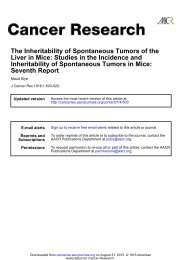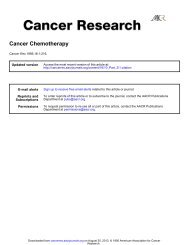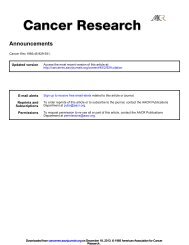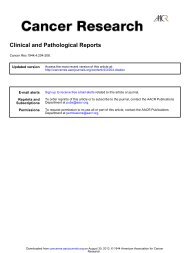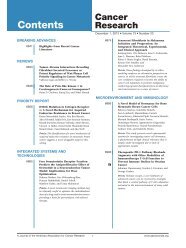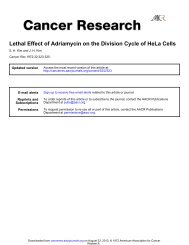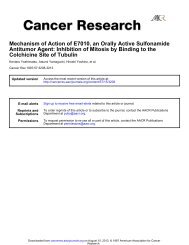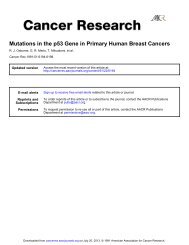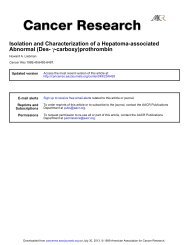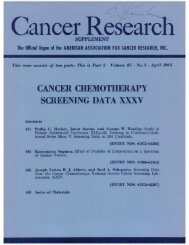Trichothiodystrophy, a Human DNA Repair ... - Cancer Research
Trichothiodystrophy, a Human DNA Repair ... - Cancer Research
Trichothiodystrophy, a Human DNA Repair ... - Cancer Research
Create successful ePaper yourself
Turn your PDF publications into a flip-book with our unique Google optimized e-Paper software.
CT.100<br />
E 60<br />
20<br />
O NORMAL<br />
•P2<br />
•P3<br />
036 24<br />
TIMEth]<br />
<strong>DNA</strong> REPAIR DEFECT IN TRICHOTHIODYSTROPHY<br />
Fig. 5. Removal of UV endonuclease-sensitive sites. Cells were incubated for<br />
various times after UV irradiation with 4 J/m2. Normal cells labeled with<br />
[MC]thymidine (0.05 fiCi/ml) mixed with TTD cells labeled with [3H]thymidine<br />
(5 >iCi/ml) were permeabilized and incubated with a crude fraction ofMicrococcus<br />
luteus extract containing UV endonuclease activity. The mixture was lysed on top<br />
of alkaline sucrose gradients. The number of breaks (UV endonuclease-sensilive<br />
sites) was calculated from weight-average molecular weights of the molecular<br />
weight distribution of the <strong>DNA</strong> molecules. Bars, SEM.<br />
ularly at higher doses, the level after 10 J/m2 being some 40%<br />
of that in normal cells (Fig. 3.4). The repair synthesis step of<br />
the excision-repair process can be measured in several different<br />
ways. The results in Fig. 3A were obtained by measurement of<br />
incorporation of [3H]thymidine into UV-irradiated cells the<br />
semiconservative <strong>DNA</strong> replication of which had been inhibited<br />
by hydroxyurea (16). This experimental procedure was devel<br />
oped for rapidity, but it is not completely rigorous (see Ref.<br />
16). We have therefore also measured repair synthesis in normal<br />
and P3 cells by autoradiography (Fig. ÃŒB) and by equilibrium<br />
centrifugation in alkaline CsCl gradients (Fig. 3C). The results<br />
using all three procedures were similar and demonstrated a<br />
clear deficiency in excision-repair in P3 despite its normal<br />
survival.<br />
The deficiency in UDS in P3 enabled complementation tests<br />
to be carried out, and the results in Table 2 show that P3, like<br />
P2, failed to complement the Italian TTD cell strains, whereas<br />
they did complement XPs from complementation groups C<br />
(XP9PV) and A (XP25RO).<br />
The discrepancy between the normal responses of P3 cells<br />
shown in Figs. 1, 2, and 5 and the defective repair synthesis<br />
shown in Fig. 3 prompted us to carry out a more detailed<br />
examination of excision-repair in P3 cells.<br />
Kinetics of Excision-<strong>Repair</strong>. The rate of the incision step of<br />
excision-repair can be measured by inhibiting the repair synthe<br />
sis step with a combined treatment of hydroxyurea and 1-0-Darabinofuranosylcytosine<br />
and then measuring the accumulation<br />
of incision breaks in the <strong>DNA</strong> (26). The dose responses for the<br />
number of breaks accumulated in 30 min following UV irradi<br />
ation (Fig. 6) were very similar to those obtained in the repair<br />
synthesis experiments (Fig. 3). Breaks were barely detectable in<br />
strain P2, and in P3 they were reduced to about 50% of that in<br />
normal cell strains.<br />
The UDS and incision break experiments in which a defi<br />
ciency in P3 cells was revealed differed from the cellular exper<br />
iments and the UV endonuclease assay in two respects. The<br />
former assays were carried out over a short period of time<br />
immediately after UV irradiation, and they used nondividing<br />
cells, whereas the latter were long-term measurements using<br />
dividing cells. In order to ascertain whether these differences in<br />
conditions could account for the apparent discrepancies in our<br />
observations we have measured repair replication in dividing<br />
cells and extended our measurements over a period of 24 h.<br />
Fig. 3D shows the dose response for repair replication in<br />
dividing cells over a 3-h period. The results are similar to those<br />
6093<br />
'O<br />
01234<br />
•48BR Inormals<br />
e GM730I<br />
•P2<br />
•P3<br />
UYDOSElOrtfl<br />
Fig. 6. Incision breaks. Nondividing cells were incubated for 30 min in the<br />
presence of hydroxyurea and l-#-D-arabinofuranosylcytosine following UV irra<br />
diation with different doses. The weight-average molecular weights of the <strong>DNA</strong><br />
molecules were calculated after centrifugation in alkaline sucrose gradients, and<br />
the number of breaks was determined.<br />
CC 3<br />
UJ<br />
u.<br />
ü2<br />
"-> 1<br />
o GM 730<br />
•P3<br />
6 12<br />
T i m e (h)<br />
Fig. 7. Time course of repair replication. "P-labeled exponentially growing<br />
cells were UV irradiated with a fluence of 10 J/m2 and incubated for various<br />
times in the presence of hydroxyurea, |3H]thymidine, and bromodeoxyuridine.<br />
The specific activity of the repaired<br />
alkaline CsCl gradients.<br />
<strong>DNA</strong> was measured by centrifugation in<br />
Table 3 <strong>Repair</strong> replication at different times after L'y irradiation<br />
12P-Labeled dividing cells were UV irradiated (10 J/m2) and incubated with<br />
[3H)thymidine and bromodeoxyuridine for the time intervals shown. The <strong>DNA</strong><br />
was centrifuged in alkaline CsCl gradients. The relative specific activity of the II<br />
to the




